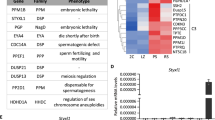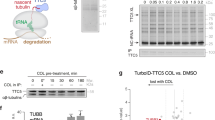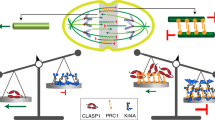Abstract
REMOVAL of the flagella from the biflagellate alga Chlamydomonas reinhardi results in the rapid production of new flagella1–3. Flagellar regeneration is 80–85% complete within 60 min (Fig. 1). Indirect evidence obtained from in vitro translation of polyribosomes and mRNA from deflagellated gametes1 has indicated that flagellar regeneration is accompanied by a strong but transient induction of tubulin synthesis. Kinetic analysis showed that tubulin mRNA could be detected in polyribosomes in as little as 15 min after deflagellation. Since the cytoplasm contains a reserve of tubulin of sufficient size to supply at least one-third to one-half of the tubulin subunits required for flagellar reassembly1,3, the rapid initiation of tubulin synthesis following deflagellation suggested the existence of a highly sensitive system for detecting and responding to the cell's anticipated need for additional tubulin. As an approach to seeking such a mechanism, we have carried out studies to determine if the depletion of tubulin reserves during flagellar outgrowth might provide the signal for the induction of tubulin synthesis. We present here two types of experimental evidence which clearly demonstrate that the induction of tubulin synthesis is independent of the utilisation of tubulin reserves during flagellar regeneration.
This is a preview of subscription content, access via your institution
Access options
Subscribe to this journal
Receive 51 print issues and online access
$199.00 per year
only $3.90 per issue
Buy this article
- Purchase on SpringerLink
- Instant access to full article PDF
Prices may be subject to local taxes which are calculated during checkout
Similar content being viewed by others
References
Weeks, D. P. & Collis, P. S. Cell 9, 15–27 (1976).
Randall, J., Cavalier-Smith, T., McVittie, A., Warr, J. & Hopkins, J. M. Dev. Biol. Suppl. 1, 43–83 (1967).
Rosenbaum, J. L., Moulder, J. E. & Ringo, D. L. J. Cell Biol. 41, 600–619 (1969).
Sagar, R. & Granick, S. Ann. N.Y. Acad. Sci. 56, 831–838 (1953).
Howell, S., Blaschko, W. & Drew, C. J. Cell Biol. 67, 126–136 (1975).
Lang, W. & Chrispeels, M. Planta 129, 183–190 (1976).
Farrell, K. J. Cell Sci. 20, 639–652 (1976).
Piperno, G. & Luck, D. J. biol. Chem. 252, 383–391 (1977).
Weeks, D. P. & Baxter, R. Biochemistry 11, 3060 (1972).
Perry, R. P. A. Rev. Biochem. 45, 605–630 (1976).
Amrhein, N. & Filner, P. Proc. natn. Acad. Sci. U.S.A. 70, 1099 (1973).
Hartfiel, G. & Amrhein, N. Biochem. Physiol. Pflanzen 169, 531–556 (1976).
Author information
Authors and Affiliations
Rights and permissions
About this article
Cite this article
WEEKS, D., COLLIS, P. & GEALT, M. Control of induction of tubulin synthesis in Chlamydomonas reinhardi. Nature 268, 667–668 (1977). https://doi.org/10.1038/268667a0
Received:
Accepted:
Issue date:
DOI: https://doi.org/10.1038/268667a0



